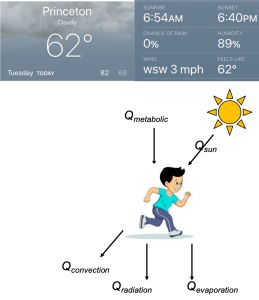Improved Heat Index for Runners
Weather stations and apps provide “feels like” in addition to actual temperatures, that account primarily for humidity in warmer weather and wind in cooler weather. These temperatures are derived from analyses of heat transfer in humans that date back to the 1970s. The approach balances the metabolic heat produced by a person walking at a casual pace with cooling by ventilation, evaporation (sweating), radiation, and convection. This approach underestimates the effects the both humidity and wind on a person who is running, and who thereby produces a higher rate of metabolic heat and is subjected to greater wind convection due to the relative effect of their own velocity. We are revisiting critically the original heat transfer analysis from the 1970s, with an eye to increasing the accuracy of the contributions to heat transfer and increasing the metabolic rate to what a runner would be producing typically. The goal is to produce an improved estimate of the effects of heat on a person running so that one can wear appropriate clothing and/or plan better the time of day to exercise safely and comfortably.
